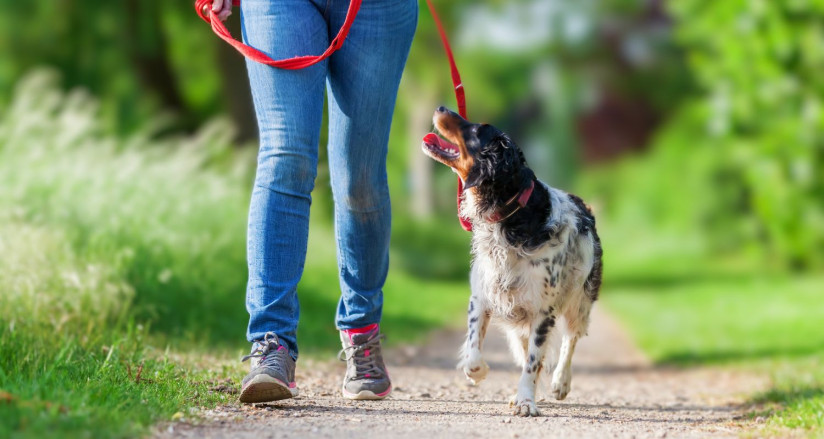Walking our dogs is a great source of exercise for both pets and pet parents. It not only helps keep our canine companions healthy and physically and mentally stimulated, but also strengthens the bond between us. There are several factors for pet parents to consider, however, to keep walks fun and safe for all.
The Basics
Most dogs benefit from between 30 minutes and two hours of physical activity per day, but it is important to monitor them for signs of fatigue or injury. If your dog is panting, slowing down, wants to stop frequently, lies down on the walk, or is reluctant to go in the first place, this may be a sign of an underlying physical issue. Always consult your veterinarian if you are concerned.
You can help gauge your dog’s capacity for exercise by observing their behavior during and after a walk. Your dog likely needs longer walks if they are pulling on the leash, displaying behavioral problems, or are overexcited at the end of their walks. If your dog strolls beside you and takes a nap afterwards, it is more likely that their needs are being met.
Other Factors to Consider
Age, breed, and size are all considerations for how far and frequently to walk your dog. Not every dog needs or can tolerate the same amount of physical activity.
Age
Older dogs and puppies both benefit from shorter and more frequent walks that don’t stress their joints and bones. Short walks a few times a day will help senior dogs get up and get moving, while puppies benefit from short walks a few times a day to help with toilet training, leash manners, and energy management.
Breed
Highly energetic breeds, like Jack Russell Terriers, may require more exercise daily. Brachycephalic (short-nosed) breeds, including Bulldogs and Pugs, may experience breathing difficulty on longer or quicker paced walks. Herding breeds, like Border Collies, may require several walks per day so they don’t go stir-crazy.
Size and Weight
A one-mile walk is far less strenuous for larger breeds, like Labrador Retrievers, than it is for smaller dogs, like Chihuahuas. If your dog is considered overweight, start with shorter walks and gradually increase your distance daily.
Do's and Don'ts
- DO call your dog to you when it’s time to leave for a walk and have them sit quietly before putting on their leash and/or collar. Ensure puppies are familiar with the leash before you start using it for walks.
- DO have your dog focus on you before you leave. Hold the leash by the handle – there should be six feet of loose leash between you and your dog.
- DO guide your dog to heel throughout the walk – your dog should walk alongside or behind you. If they are in front of you, it gives them the impression they are leading you.
- DON’T let your dog mark for marking’s sake. Cue them to whether they need to relieve themselves.
- DO walk your dog or ensure they get some exercise daily. An unexercised dog can become hyper and destructive.
- DON’T let your dog off their leash unless you’re in an off-leash dog area. Even then, do be careful – other dogs can be unpredictable.
- DO walk in different locations. Your dog will like the variety.
- DON’T forget about mental exercise, which can be more tiring for your dog than long walks. Engage your dog in a few simple training exercises, like focusing on you with a basic command or after an unanticipated directional change.
General Tips
- Make sure your dog is wearing proper identification in case of emergency or escape.
- Walking with friends and their dogs can be safer and more fun for both you and your pet.
- Don’t stop if you encounter an unsupervised dog – you might be crossing through their territory.
- Always wear comfortable, safe shoes to walk your dog.
- Aim for quality of walk over quantity. Short walks in safe environments provide opportunities to educate your dog about appropriate behavior.
- Always carry bags to pick up after your dog. Bring fresh water to keep your dog hydrated.
- Never jump in if your dog gets into a fight. Stay at the end of the leash and use it to pull your dog away. Spraying water can also be effective.
- Not all dogs are friendly – even a wagging tail can be misleading. Be respectful and always check with the owners before allowing your dog to approach.
- Hot pavement can be painful to your dog’s sensitive foot pads. If the ground feels hot to your hand, it will hurt your dog.
- Wipe down your dog’s paw pads and between their toes after winter walks to remove ice, snow, or road salts.
- If your dog is unfriendly around people or other dogs, keep a safe distance from others and seek assistance from a Bark Busters trainer.
Is Leash-Pulling Normal?
Pulling is in a dog’s DNA – in the wild, a trapped or restrained animal naturally tries to get away. Although canines have been domesticated for thousands of years, dogs still have natural instincts. To stop them from pulling, we must alter their perception by teaching them to walk on a loose leash, allowing them to relax their impulse to pull when they feel no restraint.
Avoid Retractable Leashes
Bark Busters recommends a 6-foot cotton leash – never retractable leashes, which can encourage pulling, make it easier for dogs to escape and run away, and make it more difficult for dog walkers to gain control in situations with aggressive dogs. They can also cause serious injury to both pets and humans.
Walking your dog is a great way to bond for humans and canines alike.
